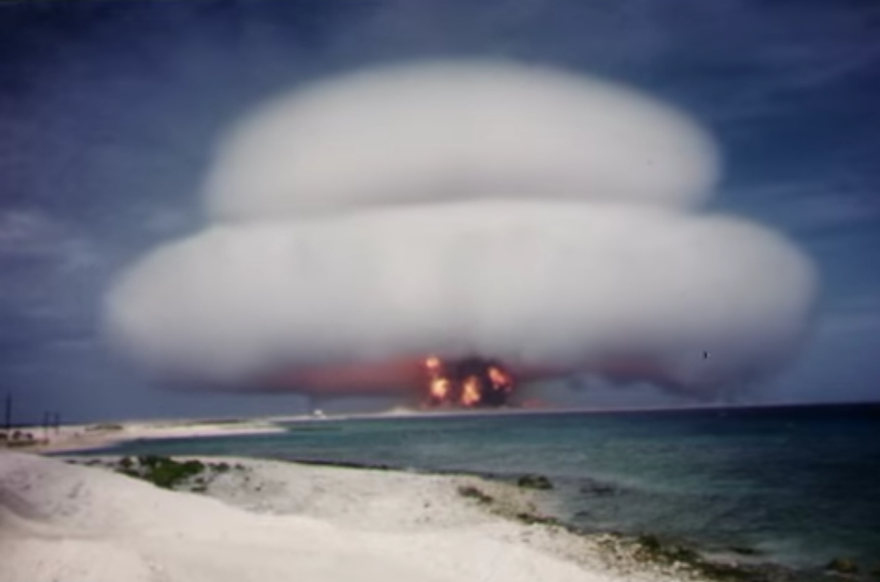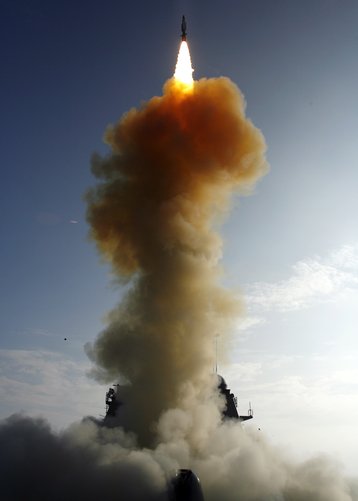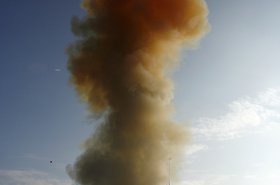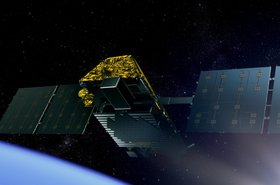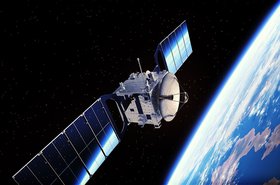During the late 1950s and early 1960s, just as the space race was heating up and Cold War tensions were growing frosty, both the US and the Soviet Union were busy developing weapons to bring down satellites almost as quickly as they were being sent up.
Within days of the Soviet Union launching its first satellite, Sputnik, in October 1957, the US began work on a response from the ground, in mid-air and from space-borne platforms.
In the 1960s, high-altitude nuclear tests showed the unintentional fallout of using weapons in space - and the fragility of satellites. But despite this, space weaponry is still being developed. After a relatively peaceful period, recent years have seen increased political tensions, and a number of satellites have been destroyed in military demonstrations.
In the weeks since this article was published in DCD’s magazine, Russia has conducted a new ASAT test; defunct Cosmos-1408 spy satellite was destroyed with a missile, creating a debris cloud of at least 200 pieces.
Since the 1960s we have come to rely on satellites for connectivity, positioning data, and scientific research. Can governments and militaries continue rattling their space sabers without impacting global communications, and their own domestic industries? Or is the world going to have to learn the hard way again?
This article appeared in Issue 42 of the DCD>Magazine. Subscribe for free today
Starfish Prime and lessons in space sustainability
After Sputnik launched, the CIA quickly issued a report warning of the potential for Soviet reconnaissance by satellite.
The US response was to develop anti-satellite (ASAT) weapons. The idea of space-borne weapons was quickly conceived, but the earliest response was a series of missile systems launched from the ground or air.
The High Virgo, or Weapons System 199C (WS-199C), missile failed, but it was followed by Bold Orion, or Weapons System 199 (WS-199B) - the first successful demonstration of an ASAT.
In October 1959 a missile was launched from a B-47 at an altitude of 35,000 feet (11,000 m); the missile came within four miles (6.4 km) of Explorer 6, a US science satellite studying radiation, at an altitude of 156 miles (251 km). The test was deemed a success; if the missile had a nuclear warhead, the satellite would have been destroyed.
Around the same time, the US was conducting a series of nuclear explosions in the atmosphere and showed the impact of space-borne weapons.
In 1958, the Hardtack program exploded three nuclear weapons over the Pacific. The 1.7 kiloton Yucca was the first high-altitude nuclear explosion; the warhead was attached to a large helium-filled balloon, and detonated at a relatively modest altitude of 26.2 km. The 3.4 megaton Teak was detonated at an altitude of 76.2 kilometers (47.3 mi), in the stratosphere. Orange – the largest high altitude test conducted at 3.8 megatons – detonated at 43 kilometers (27 mi).
While Teak and Orange caused local outages and communication disruption in the surrounding area, neither were high enough to cause damage to satellites that orbit above 250km.
Conducted the same year however, the Argus program launched three 1.7 kiloton missiles at altitudes of 200km, 240km, and 400km, which is the highest such test ever conducted, to test whether a small number of nuclear bombs detonated high over the South Pacific could create an electromagnetic shield that would destroy the on-board electronics of incoming Soviet warheads. The electromagnetic effects were tested by Explorer 4 and 5 satellites, showing that in-orbit operations were seemingly unaffected, any such electron shield created by the explosions wouldn’t last long enough to be useful.
Operation Fishbowl, designed to explore electromagnetic pulses, however, was the last such series of tests and was also the most damaging to what was then a relatively small satellite community. The first two attempts, Bluegill and Starfish, were abandoned after launch before they could detonate. Starfish Prime, however, detonated successfully and demonstrated the dangers of weapons in space in the process.
A W49 thermonuclear warhead attached to a Thor rocket was launched from the Johnston Atoll in the Pacific Ocean in July 1962. The 1.4 megaton explosion at an altitude of some 400 km (250 mi) created an electromagnetic pulse detected in Hawaii more than 1,400 kilometers (900 mi) away, reportedly knocking out around 300 streetlights, setting off numerous burglar alarms, and caused the failure of a telecoms firm’s microwave repeating station.
In orbit, a number of satellites were temporarily disabled in the explosion’s wake. Many more were damaged or lost in the following months, likely as a result of the test’s resultant radiation belt – including the US-owned Traac, Transit 4B, Injun I, Explorer 14 and 15, Relay 1, and Telstar I, as well as the UK satellite Ariel, and the Soviet-owned Cosmos V.
With only around 20-25 active satellites in orbit at the time, this means that the Starfish Prime explosion had impacted nearly half the world’s satellites. Today there are closer to 4,000 operational satellites, so any similar test would likely have a much larger impact.
Starfish Prime probably should have been the end of such tests, but the US military continued Operation Fishbowl after a few months’ pause; Bluegill Prime and DoublePrime both failed to launch properly, while the 10-20 kiloton Checkmate was successfully detonated in October 1962. Bluegill Triple Prime, Kingfish, and Tightrope also launched later that year, with no noted damage to satellites. Tightrope was the final atmospheric test conducted by the United States, after a program of five nuclear detonations as part of Fishbowl and 11 in total.
The Soviet Union carried out four of its own high-altitude tests in 1961 and three in 1962 in what is known as the K project, one of which started a fire that burned down the Karaganda power plant in Kazakhstan.
Satellites make the world go round
Today the satellite industry is a massive industry generating huge amounts of value for multiple industries, well beyond military and national defense uses. Disrupting such machines would have a significant knock-on effect on our daily lives.
Global positioning system (GPS) satellites alone have generated an estimated $1.4 trillion in economic benefits since the system was made available for non-military use in the 1980s. As well as providing location services, such global navigation systems provide timekeeping for many digital systems.
A report by The Aerospace Corporation’s Center for Space Policy and Strategy (CSPS) notes satellites are important in areas such as agriculture, fishing and maritime, environmental monitoring and weather forecasting, financial trade, and even emergency services.
“Satellites are so important to our daily lives,” says Makena Young, research associate with the Aerospace Security Project at the Center for Strategic and International Studies (CSIS). “If a main satellite system went down, it would just wreak havoc on our daily society; things like banking would really slow down or stop completely for a few days.”
In the US, military personnel such as General John Hyten have previously spoken about the need to make more public demonstrations of the US’ space weapon capabilities in order to deter adversaries.
Essentially, the likes of Hyten argue that treating these weapons as military secrets means that potential enemies don’t know they exist, so they have no deterrent effect. Breaking Defense reports Hyten saying the US “over-classify everything in space,” and that “deterrence does not happen in the classified world.” However, such demonstrations in a global operating environment such as orbit creates risks for everyone.
While geostationary satellites are large, multi-ton machines built to withstand the harsh environs of space, there’s little that can protect them from a targeted ASAT missile strike. And as well as taking out the large GEO satellites, ASAT use would create a large cloud of debris which would prove instantly fatal to the growing number of low earth orbit (LEO) satellites that are much smaller, lighter, and faster.
A destroyed satellite can cause a cascade; each trackable piece of debris can potentially destroy another satellite, which in turn can create more debris that can destroy other satellites. Kessler Syndrome warns of a scenario where an excess of space debris begins to collide uncontrollably with satellites, causing an unstoppable cascade of collisions and debris that could render orbits unusable by satellites or manned missions for generations.
The indiscriminate nature of space means that as well as hurting local industry and global connectivity, military operations can easily be disrupted by debris and conjunction events. Earlier this year, the Yunhai 1-02 Chinese military satellite collided with a piece of debris from the Zenit-2 rocket that launched Russia's Tselina-2 spy satellite in September 1996 and has since broken up.
Any prolonged combat in space would likely impact a high number of satellites for years to come.
“ASATs are really dangerous for everyone,” says CSIS’ Young. “Space is very different than on the ground... If you blow up a satellite, that satellite breaks up into thousands of different pieces and then they just continue to orbit, and they can hit any number of satellites.”
“If Russia were to blow up a US satellite, that space debris could easily take out a dozen Russian satellites in the same orbit.”
Wargames in space threatens everyone’s satellites
The 1963 Partial Nuclear Test Ban Treaty prevented further high-altitude nuclear tests and the 1963 Outer Space Treaty prohibited the placing of nuclear weapons in space, but the US and Soviet Union continued testing and developing a number of ASAT weapons systems that didn’t rely on nuclear weapons in order to avoid breaking the treaty or damaging their own satellites with EMP.
Many ASAT systems are kinetic weapons relying on missiles. Building on the High Virgo and Bold Orion tests and following Program 505 – where counter-missile systems were explored as anti-satellite weapons – the US Military’s Program 437 anti-satellite weapons program continued from the early 1960s until 1975. The US also had the Satellite Interceptor Program (SIP). But despite all the years of testing, only two US satellites have been actually destroyed since Starfish Prime.
In 1985, despite an incoming block on ASAT testing in the US from the Senate, an ASM-135 missile launched from an F-15 was used to destroy the Solwind P78-1 satellite in a test; the debris from the explosion meant NASA had to enhance shielding for its planned space station. The last piece of tracked debris from this test fell out of orbit more than 15 years later in 2002.
In February 2008, the US Navy destroyed the malfunctioning US spy satellite USA-193 from a decaying orbit using a modified RIM-161 Standard Missile 3 fired from a warship in the Pacific. The satellite was officially destroyed due to the presence of hydrazine and beryllium on board and the potentially hazardous effect the chemicals could have if they leaked over a populated region.
The Soviet Union also developed its own ASAT capabilities via ballistic missiles during the 1960s and 1970s. The program was named Istrebitel Sputnikov, meaning "destroyer of satellites" and did exactly that to several orbiting systems.
The Soviets explored using anti-satellite lasers at the Terra-3 laser testing center, but seemingly were unsuccessful at the time. The US also tested ground-based anti-satellite lasers to varying levels of success up to the late 1990s. Both countries are assumed to have non-kinetic, energy-based ASAT systems that aren’t publicly disclosed.
Since the fall of the Soviet Union, Russia has continued to develop and operate ASAT weaponry and has conducted a number of tests without destroying any satellites in recent years up until the 2021 demonstration.
New millenium, same threats
The 1990s saw little in the way of space conflict or demonstrations, but since the turn of the new millennium tensions have gradually risen and weaponization has escalated.
In January 2001, a space commission headed by Donald Rumsfeld recommended that “the US government should vigorously pursue the capabilities called for in the National Space Policy to ensure that the president will have the option to deploy weapons in space to deter threats to, and, if necessary, defend against attacks on US interests.” The US then withdrew from the Anti-Ballistic Missile Treaty in 2002.
That same year, the Pentagon announced the US would continue the “development and testing of space-based defenses, specifically space-based kinetic energy [hit-to-kill] interceptors and advanced target tracking satellites.”
After more than 20 years without incident – and including the most recent Russian test – there have been four intentional ballistic tests on satellites in the last 15 years. Four countries have demonstrated ASAT capabilities; the US, Russia, India, and China. Though none have been recorded as used in conflict, such demonstrations often lead to similar reactions by rival nations and increased tensions. Israel is also reportedly developing an ASAT system.
“Every new space power seems to have some desire to show that they can do it,” says Dr. Holger Krag, head of the Space Safety Programme Office for the European Space Agency. “My hope is that once they have shown it, they don't need to repeat it. There are disruptions to spaceflight every time it happens.”
“We have already many many unintentional events. And these cannot be prevented. For those that you can control, if they cannot be avoided, they must be done in a very careful way.”
China has reportedly been working on ASAT capabilities since the 1960s; originally through the Program 640 missile development initiative and then through the wide-reaching Program 863 for high technology development. China has also reportedly been developing laser/energy-based weapons that could disable enemy satellites without destroying them and causing debris; in 2006, China reportedly illuminated a US satellite with a ground-based laser, perhaps more than once.
The Chinese military launched an anti-satellite weapon on January 11 2007 destroying the Fengyun-1C (FY-1C) weather satellite. The 750 kilogram (1,650 lb) satellite was struck by a missile at an altitude of 865 kilometers (537 mi). It was the first such destruction of a satellite since 1985.
In the aftermath, Chinese Foreign Ministry spokesman Liu Jianchao stated that "there's no need to feel threatened about this" and argued that "China will not participate in any kind of arms race in outer space."
China has since tested a number of ASAT missiles without destroying more satellites. US officials have said its destruction of its USA-193 in 2008 was not a demonstration of its own capabilities in response to the Chinese test.
The aftermath of the 2007 Chinese test is still being felt today. Where USA-193 created 174 pieces of orbital debris, the last of which re-entered the atmosphere some 20 months later in October 2009, the FY-1C demonstration created 40,000 pieces of debris larger than 1cm. Several thousand remain in orbit today, more than 10 years later.
“The Chinese test was the absolute worst because they destroyed a large one-ton satellite right in the most popular orbit, at an altitude where the debris takes a long time to come down,” says astrophysicist Jonathan McDowell of the Harvard-Smithsonian Center for Astrophysics.
India has developed its own ASAT capabilities, and successfully conducted an ASAT test under the project name Mission Shakti. In March 2019, a missile fired from Kalam Island struck a test satellite – thought to be Microsat-R – at a relatively low 283-kilometer (176 mi) altitude. More than 200 pieces of debris were created, though only four pieces remained in orbit at the start of 2021.
“The Indian test, they thought they would try to be good, and relatively speaking, they were good,” says McDowell. “But when you have these collisions some of the debris goes up to higher apogees. Most of their debris went down right away but they did have a couple of hundred pieces of debris that were tracked in orbit for months.”
Planet Satellites at the time said “destroying satellites on-orbit severely threatens the long term stability of the space environment for all space operators. Planet urges all space-capable nations to respect our orbital commons.”
At the time, then-NASA Administrator Jim Bridenstine called the Indian test a “terrible, terrible thing” that is “not compatible with the future of human spaceflight.”
“It’s unacceptable and NASA needs to be very clear about what its impact to us is,” he said, adding that all commercial and civil space activities “are placed at risk” by such tests and that “when one country does it, other countries feel like they have to do it as well.”
Reasons to be peaceful
In June 2021, NATO expanded Article 5 – which requires member states to come to the aid of any member state subject to an armed attack – to include attacks against a country’s space-borne assets. This means that any attack on a NATO-member satellite could cause retaliation in space and on Earth from up to 30 countries.
“We consider that attacks to, from, or within space present a clear challenge to the security of the Alliance, the impact of which could threaten national and Euro-Atlantic prosperity, security, and stability, and could be as harmful to modern societies as a conventional attack,” NATO said in a communique. “Such attacks could lead to the invocation of Article 5.”
But not all global efforts are aimed at ramping up tensions in space. In December 2020 the UN adopted resolution 75/36 aimed at “reducing space threats through norms, rules, and principles of responsible behaviors” that will hopefully lead to a UN-wide set of principles and rules on “responsible behaviors” for space. Another resolution, 75/60, was passed reaffirming the non-proliferation of ballistic missiles in space.
There are other proposed international agreements, such as the treaty on the Prevention Of The Placement Of Weapons In Outer Space, The Threat or Use of Force Against Outer Space Objects (PPWT), the EU International Space Code of Conduct, as well as the Prevention Of An Arms Race In Space (PAROS) Treaty that would prevent signatories from placing objects carrying any type of weapon into orbit, installing weapons on celestial bodies, and threatening to use force against objects in outer space.
None so far have been successfully adopted globally. The US often votes down any legal regimes or other mechanisms that would restrict its access to or use of space, including any arms control proposals that would impinge on military space acquisitions or operations.
Resolution 75/36, which was introduced by the UK, seems the most likely to succeed in the long term, but it could be years before any sort of binding agreement emerges. But at least it shows that countries around the world recognize the importance of keeping the peace in space. Hopefully, we won’t have another Starfish Prime before then.
But if an agreement can’t be made between world leaders, it is hoped that the space industry itself can make a case for keeping the peace.
“In just the past few years commercial space has started to totally dominate versus military and civilian space,” says McDowell. “If your country is active in military space but it also has a big commercial space sector, there's an internal political discouragement from screwing up things for the commercial people.
“That might, I hope, discourage some of these countries from actually doing more of these tests because the commercial people are not going to be happy with the extra debris.”
“There's a strong need for us to go 'no, just don't do that.’ We have enough problems with accidental debris. Don't create deliberate debris, it's just not the thing to be doing.'”
CSIS’ Young notes that the dynamic is changing as the military and Government become more dependent on commercial operators. This could potentially give large companies more influence to help reduce potential weaponization in space.
“Commercial actors are becoming so much more vocal in space. A lot of commercial companies are vital to giving information to the government and that relationship is becoming a lot more important and we rely on some of these commercial companies more than we have in the past.”

